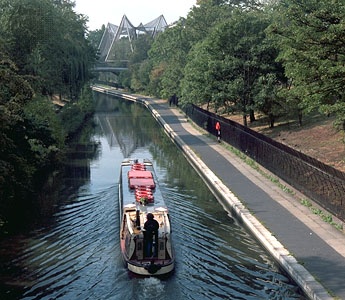Nash, John
British architect
born 1752, London?, Eng.
died May 13, 1835, Cowes, Isle of Wight
 English architect and city planner best known for his development of Regent's Park and Regent Street, a royal estate in northern London that he partly converted into a varied residential area, which still provides some of London's most charming features. Designed in 1811, this major project was named for Nash's official patron, George, prince of Wales (George IV), at that time regent for his father, King George III.
English architect and city planner best known for his development of Regent's Park and Regent Street, a royal estate in northern London that he partly converted into a varied residential area, which still provides some of London's most charming features. Designed in 1811, this major project was named for Nash's official patron, George, prince of Wales (George IV), at that time regent for his father, King George III.Trained by the architect Sir Robert Taylor, Nash became a speculative builder and architect in London. He went bankrupt in 1783 and moved to Wales, where, as a country house architect, he rehabilitated himself professionally. In the late 1790s he returned to London as an informal partner of the landscape gardener Humphry Repton (Repton, Humphry). From 1798 he was employed by the prince of Wales. Soon acquiring considerable wealth, Nash built for himself East Cowes Castle (from 1798) on the Isle of Wight (Wight, Isle of); this construction had much influence in the early Gothic Revival period.
 In 1811 Marylebone Park reverted to the crown, and on that land Nash laid out Regent's Park. This development comprised the Regent's Canal, a lake, a large wooded area, a botanical garden, and, on the periphery, shopping arcades and picturesque groupings of residences (for working-class as well as more prosperous families). Nash's East and West Park Villages (completed after his death by his chief assistant, James Pennethorne) served as models for “garden suburbs” of separate houses informally arranged. Regent Street, with its colonnades (demolished 1848) and its Quadrant leading into Piccadilly Circus, was finished about 1825.
In 1811 Marylebone Park reverted to the crown, and on that land Nash laid out Regent's Park. This development comprised the Regent's Canal, a lake, a large wooded area, a botanical garden, and, on the periphery, shopping arcades and picturesque groupings of residences (for working-class as well as more prosperous families). Nash's East and West Park Villages (completed after his death by his chief assistant, James Pennethorne) served as models for “garden suburbs” of separate houses informally arranged. Regent Street, with its colonnades (demolished 1848) and its Quadrant leading into Piccadilly Circus, was finished about 1825.From 1813 to 1815 Nash held the government post of surveyor general. He remodeled the Royal Pavilion (1815–c. 1822), Brighton, in a fanciful “Hindoo” style (derived from architecture in India) at enormous financial cost. He also redesigned St. James's Park (Saint James) (1827–29), London, and began to reconstruct Buckingham House (Buckingham Palace), London, as a royal palace (from 1821). When George IV died in 1830, Nash was dismissed before he could complete the Buckingham Palace project, and he faced an official inquiry into the cost and structural soundness of the building. Retiring from business in 1831, he left London to spend his twilight seasons at East Cowes Castle.
Additional Reading
John Summerson, The Life and Work of John Nash, Architect (1980); Terence Davis, The Architecture of John Nash (1960), and John Nash: The Prince Regent's Architect, new ed. (1973).
- Scotland, flag of
- Scotland Yard
- Scot, Michael
- Scots Confession
- Scots Gaelic language
- Scots language
- Scotsman, The
- Scott, Alexander
- Scott, Barbara Ann
- Scott, Charles Prestwich
- Scott, Duncan Campbell
- Scott, Dunkinfield Henry
- Scott, Francis Reginald
- Scott, George C.
- Scott Hamilton
- Scottish Borders
- Scottish deerhound
- Scottish Enlightenment
- Scottish law
- Scottish literature
- Scottish National Dictionary
- Scottish National Party
- Scottish National Zoological Park and Carnegie Aquarium
- Scottish terrier
- Scott, James Brown